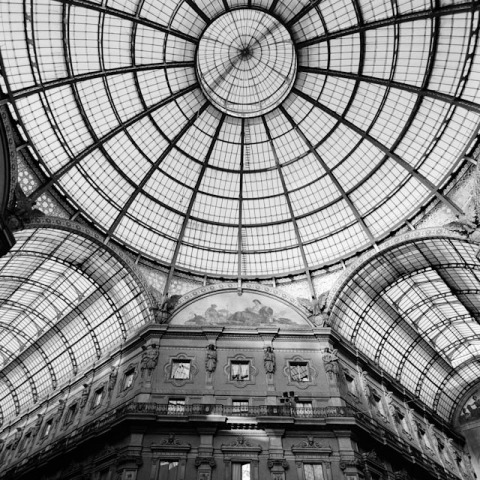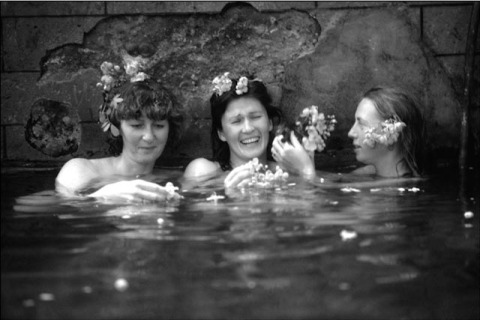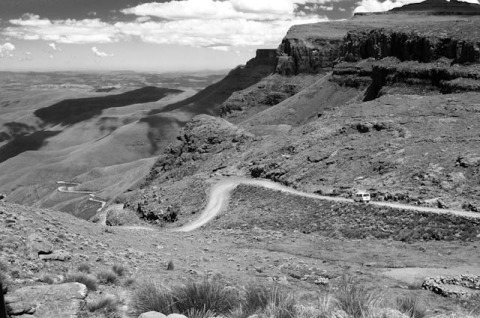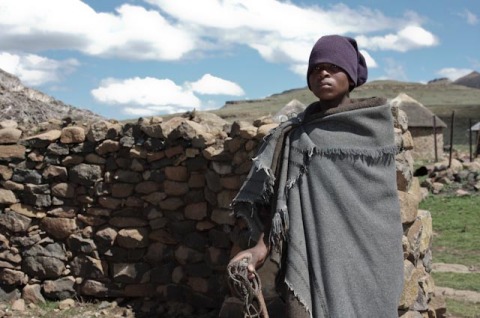The French use stripes extensively in their decor and fashion, and this last summer, during my fourth trip to France, I was on the hunt for striped beach tents that I had seen in a vintage photo some time back. After spending a few days on the Normandy coast, searching without much success, I finally tracked these down at Trouville beach.
 Beach Umbrellas #1, Trouville, France. 2010 © John Queenan
Beach Umbrellas #1, Trouville, France. 2010 © John Queenan
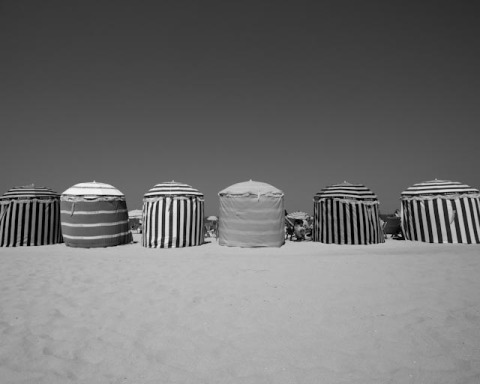 Beach Umbrellas #3, Trouville, France. 2010 © John Queenan
Beach Umbrellas #3, Trouville, France. 2010 © John Queenan
The striped tents certainly give the beach a nostalgic air. The original beach tents first appeared a long time ago, when the the fashion for bathing in the sea started at the beginning of the 19th Century.
This was the time of the first sea water therapies and tents were used by the patients for undressing and to rest in after invigorating swims in the sea. The tent remains the focal point for families, a beach accessory, which adds a certain charm to the beach at Trouville.
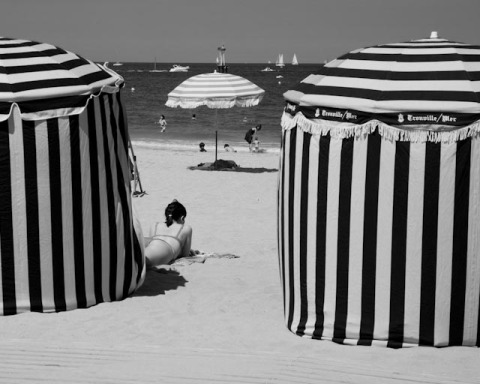 The Beach, Trouville, France. 2010 © John Queenan
The Beach, Trouville, France. 2010 © John Queenan
There are more images from Trouville on my website, wwwjohnqueenan.com.
 Pioneer Elevator, Saskatchewan, Canada. 2004 © John Queenan 2004
Pioneer Elevator, Saskatchewan, Canada. 2004 © John Queenan 2004
A few years ago I was in rural Saskatchewan for the first time, shooting an interview for a TV documentary. As usual I’d brought my stills camera along as well, although on the first day I realized I only had one roll of film in my bag, and that was a fast grainy 1600 iso. The resultant images were grainy indeed but I like them, I just wish I had had more time there, and more film. This is an amazing landscape almost lunar in places, and the first time I had seen real tumbleweed.

Car, Saskatchewan. 2004. © John Queenan 2004
What struck me was the desolation of an area that had once been a thriving farming community full of villages, grain elevators, churches and schools. Over the last 20 years due to a number of circumstances that converged to create a mood of gloom and despair ; farmers gave up the unequal struggle against the growing globalization of the food industry and massive crop productions which served to obliterate the small farms that had been around for generations.

Abandoned Farm Buildings, Saskatchewan. 2004 © John Queenan 2004
Immigrants who had toiled against the unforgiving climate and conditions in order to carve out a life on the prairies only to be defeated in the end by big business. So called ‘progress’ has created ghost towns across a once populated landscape of rural communities, leaving nothing behind but the once proud elevators looming above the stark landscape as a reminder. couldn’t help remind me of the small towns in Europe clustered around the towering churches.  Osage Elevator, Saskatchewan. 2004. © John Queenan 2004
Osage Elevator, Saskatchewan. 2004. © John Queenan 2004
The documentary was a sad one, a story on Alzheimers that had afflicted the father of a farming family, the landscape didn’t help, the journalist I was working with was overcome with tears during an interview with his wife.
I hope to find the time to return and shoot more.
Rooftiles, Spain. 2005 © John Queenan 2005
The question often arises as to what exactly is fine art photography?
The term fine art can often be mistakenly thought to denote the quality of the artwork in question, but the term “fine” refers simply to the purity of the discipline, and that is art created for no other purpose than providing beauty and enjoyment rather than commercial use. Painting and sculpture are some of the best known examples of the fine arts.
It is said that fine art photography would therefore be the work that is created to express the feelings or visions of the photographer. It can also be defined by what it is not. It is not like commercial photography, in that it is not produced to sell a product or promote an image. It is not journalistic in nature where a photograph is taken to capture or tell a visual story that coincides with a written one. Fine art photography really came into it’s own in the 1970’s when some galleries started featuring photography exclusively, and collectors started taking more of an interest.
Galleria Vittorio Emanuele, Milan 2004 © John Queenan 2004
As far as my own photographs are concerned, they were often simply scenes that played out in front of me and I captured them with a camera, more documentary than anything else, in fact the only posed shots are the portraits. My own work is often produced when I find myself in a situation or place that is so unique, aesthetically beautiful, or deemed by me to be important, that it simply demands to be recorded and shared with others. I think that is what inspires me the most!
Wives, Lilani Hotsprings, South Africa. 1983 © John Queenan 1983

Little Lions Head, South Africa. 2005 © John Queenan 2005
Sani Pass, Lesotho. 2007. © John Queenan 2007
The Kingdom Of Lesotho is a small landlocked country within South Africa. One of the key entry points to Lesotho is via the Sani Pass, originally developed as a bridle path in 1913 as a passage for wool and mohair traders, this steep zigzagging pass climbs the face of the Drakensberg escarpment to an altitude of 2874m. The Sani Pass is the only access from KwaZulu Natal in South Africa, to the harsh environment of the Lesotho Highlands, the domain of the Basotho shepherds and their animals.
Basotho Shepherd #3, Lesotho. 2007. © John Queenan 2007
Basotho Shepherds with Angora goat. Lesotho. 2007. © John Queenan 2007
In the early 19th century, having incurred the wrath of Shaka Zulu, the Basotho people fled to the vastness of the Maluti Mountains, where even Shaka’s Impis failed in their attempted to follow them over the plateau of over 3000 meters. Here they developed a unique culture. As one of the few African tribes living in a mountainous environment, they have made many adaptations to their conditions. The Basotho blanket is one example. All around the country you will see people dressed in woollen blankets, often with beautiful patterns. This is the ideal garment for a cold environment, and also has the versatility of keeping the rain off. The shepherds spend the warmer summer months, with their herds of angora goats and merino sheep, on the escarpment living in their huts for the season. Before winter arrives they leave the area and head for the warmer lowlands.
Basotho Shepherds, Lesotho. 2007. © John Queenan 2007
Basotho Shepherd Boy #2, Lesotho. 2007. © John Queenan 2007
The Sani Pass is often impassable in the winter due to snow and ice. The first vehicle negotiated the path in 1948 when it was no more than a boulder littered donkey track. The route, aptly called the “Roof of Africa”, boasts to be the highest road in Africa and third highest in the world and peaks at a heady height of 3200m above sea level! Close to the Sani Pass summit, within a couple of kilometres, is the highest peak in Southern Africa, Thabane Ntlenyana, 3482m high.
I was there in December 2007 and construction had just started on tarring the pass, a project expected to last 5 years, it will certainly have a dramatic impact on the area.
Basotho Shepherd #2, Lesotho. 2007. © John Queenan 2007
See these and more relating photographs at www.johnqueenan.com
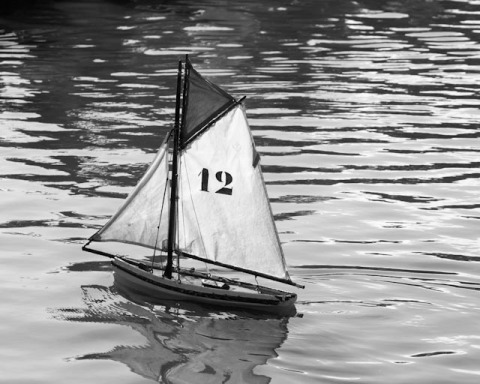 Model Sailboat, Luxembourg Gardens, Paris. 2008. © John Queenan 2008
Model Sailboat, Luxembourg Gardens, Paris. 2008. © John Queenan 2008
Last time I was in Paris I spent some time in Luxembourg Gardens, where there is a marvelous pond with these handcrafted wooden sailboats available for children to rent and sail across the water. I loved the fact that each of the boats, and I must have seen close to fifty on the water, were all different and unique. Seemed to be from a different time, it’s a very tranquil place. My designer friend Julia Black of Pure Design has a print of this photograph, she loves the numbers.
Walking Musician, Paddock, South Africa. 2007. © John Queenan 2007
In South Africa many people still walk long distances, as they always have, and to lighten the load they would often play an instrument and sing while they walked.
This music by the man on the move is called ‘maskanda’, the songs are of real life experiences, daily joys and sorrows, and opinions of the world.
It’s the music of the man who’s got the Zulu blues.
The music has changed a lot over the years, traditional instruments have been replaced by concertinas and guitars which have been tuned to reflect the polyrythmic sounds of age-old African music. I can remember as a child hearing the approaching music as the maskanda musician came up the road past our house.
This photograph was taken in Paddock, South Africa during a visit in 2007. I was busy taking a picture of the trading store in the background when he came down the road, I asked him to pose for me, we agreed on a price, I took the shot, slipped the money in his pocket and he was on his way, all without missing a beat.
To get a taste of maskanda music :- http://www.youtube.com/watch?v=jIxTGAbBXRQ
Artist’s House, Swaziland. 1975. © John Queenan 1975
While living in South Africa we would often do trips up to Swaziland, a small landlocked country situated between Mozambique and the north east corner of South Africa. There was a hippie artist community there and this was the house of a batik artist, a friend of a friend. The drive from our home in Durban was about 4 hrs and we would head up in the VW camper and set up camp near a river or hot spring, a piece of paradise!
I have a print of this photo on my wall in Toronto, I like it, it’s a reminder of a different way to live.
Previous Post
November 2, 2009
Police Station, Paris, France. 2008. © John Queenan 2008
There are so many interesting buildings in Paris, this one is certainly different. Walking along the Promenade Plantee, a disused railway viaduct, now a landscaped walkway, you get this fantastic view of the Art Deco police station. I waited till I had pedestrians in just the right place.
The frieze is inspired by Michelangelo’s “Dying Slave“. The Art Deco movement originated in Paris in 1925.
I was in France for a shoot last year, see more photographs of Paris at www.johnqueenan.com

Police Station Facade, Paris. 2008. © John Queenan 2008

Farm in Mist, South Africa. 1975. © John Queenan 1975
It was suggested to me that I share some of the stories behind the pictures on my website, so this is one of the reasons for this blog. This is one of my earlier pictures from South Africa. The location is Jabulani Estates, a sugar farm in the Paddock region of Natal. The horse was an arab gelding named Silver Owl, the stables were in the buildings on the left. The farm was in a hilly area and sometimes enveloped in mist in the morning. I particularly like the two figures in the doorway, some of the labourer’s children. The farm belonged to the family of my girlfriend at the time, Sandra, we were later married.
Welcome to my blog. I will be posting photography related material as well as news of my own photographs for sale listed on my website at http://www.johnqueenan.com. Hope you will be entertained and informed!
John.

